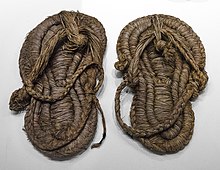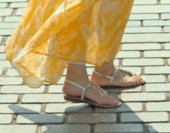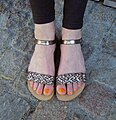Sandal
(Redirected from
Sandals
)

Sandals are an open type of shoe, consisting of a
instep and around the ankle. Sandals can also have a heel. While the distinction between sandals and other types of footwear can sometimes be blurry (as in the case of huaraches—the woven leather footwear seen in Mexico, and peep-toe pumps), the common understanding is that a sandal leaves all or most of the foot exposed. People may choose to wear sandals for several reasons, among them comfort in warm weather, economy (sandals tend to require less material than shoes and are usually easier to construct), and as a fashion choice. Usually, people wear sandals in warmer climates or during warmer parts of the year in order to keep their feet cool and dry. The risk of developing athlete's foot is lower than with enclosed shoes, and the wearing of sandals may be part of the treatment
regimen for such an infection.
Name
The
.History



Although some other kinds of
The
straw
(dried grasses). The wealthy sometimes used gems or gold or silver beads on the thongs.
Straw shoes, sometimes in the form of sandals and sometimes carbatinae, were ubiquitous Chinese footwear in antiquity.
In
Hellenistic Period, some sandals show evidence of extreme ornamentation. One found from the settlements in Greek Crimea was a platform design with 12 separate layers in its sole and gold decoration.[8]
Because of the general discomfort of the typical
calcei while carrying the shoes to be removed under the arm. The guest would change in the entryway and then have slaves remove the second pair of shoes in the dining room.[8]
In his autobiography Edward Carpenter told how sandals came to be made in England:
While in India
Millthorpe in 1889; making, I suppose, about a hundred or more pairs a year; and since his death it has been carried on at the Garden City, Letchworth.[11]
Construction

A sandal may have a
high
) or heel strap.
Variants
- Barefoot sandals, footwear with the appearance of sandals but lacking a sole.
- Caligae, a heavy-soled classical Roman military shoe or sandal for marching, worn by all ranks up to and including centurion
- Carbatina, open footwear worn in ancient Greece, Italy and the Middle East
- Clogcan be formed as a heavy sandal, having a thick, typically wooden sole.
- Crochet sandals[12]
- Fisherman sandal is a type of T-bar sandal originally for men and boys. The toes are enclosed by a number of leather bands interwoven with the central length-wise strap that lies along the instep. An adjustable cross strap or bar is fastened with a buckle. The heel may be fully enclosed or secured by a single strap joined to the cross strap. The style appears to have originated in France.
- Flip-flops are typically cheap and suitable for beach, pool, or locker room wear
- Geta, a classical Japanese form of elevated thong, traditionally of cryptomeria wood; the crosspiece is referred to as a ha, which translates to tooth
- gladiator sandal
- High-heeled sandal, a type of sandal with an elevated heel. They allow the wearer to have an open shoe while being less casual or more formal, depending on the style of the sandal.
- trekking sandals are designed for hiking or trekking in hot and tropical climates, usually using robust rubber outsole, suitable for any terrain, and softer EVA or Super EVA foam insole. These sandals are usually shaped to support the arched contour of the foot. The straps are usually made of polyester or nylon webbing for quick drying after exposure to water and to minimize perspiration.[13]Also suitable for many other adventure sports and activities where quick drying and reduced perspiration is required, including rafting, traveling, paragliding, skydiving.
- cottage industry footwear, the soles cut from an old automobile tire and the straps cut from an inner tube. Made and worn in many countries, they became wider known in the US as worn by the rural people of Indochina during the Vietnam War, leading to the name.
- Huarache, a Mexican sandal,[14] with sole made of a tire tread, or huarache (running shoe), a flat sandal used by minimalist runners.
- Jelly sandals or jelly shoes were originally a version of the classic fisherman sandal made in PVC plastic. They were invented in 1946 by Frenchman Jean Dauphant in response to a post-war leather shortage. Later designs featured translucent soft plastic in bright colours; hence the later name of jelly sandals or jellies. Recently, a whole range of styles have been produced in this material, mainly for women and girls, but the classic unisex design remains popular.
- Jesuslatschen[15]
- Jipsin, a traditional Korean sandal made of straw
- Ojota, an extremely durable Peruvian sandal made of recycled tires that is traditionally worn in the Andes by Quechua people.[16][17][18]
- Paduka are the ancient (as old as the time of the Ramayana) Indian toe-knob sandals. They are not really worn on a daily basis now except by monks or for ceremonial purposes.[19]
- Patten, a type of oversized clog often with a wooden sole or metal device to elevate the foot and increase the wearer's height or aid in walking in mud
- Roman sandal, a sandal held to the foot by a vamp composed of a series of equally spaced, buckled straps
- Saltwater sandals, a flat sandal developed in the 1940s as a way of coping with wartime leather shortages, primarily worn by children
- Soft foam sandals, invented in 1973, are made from closed-cell soft foam and uses surgical tubing for the straps. They are sold primarily along the Texas Gulf Coast in beach side gift shops.
- T-bar sandals, primarily for children, with an enclosed heel and toe. It is fastened by a cross-wise strap or bar secured by a buckle, or more recently by Velcro. A length-wise strap extends from the vamp and joins the cross-strap over the arch of the foot to form a T shape. A common variant has two cross-straps. The toe is often pierced with a pattern of holes or slots. The sole is low-heeled and usually of crepe rubber, stitched-down to the upper. First seen in Europe and America in the early 20th century, by the 1950s they were very common for boys and girls up to their teens, but are now mainly worn by much younger children.[20] This style or similar styles are also called "Mary Jane" shoes.
- Waraji, Japanese straw sandals common in the Edo period
- Wörishofer, a ladies' sandal with a cork wedge heel
- Zōri, a flat and thonged Japanesesandal, usually made of straw, cloth, leather, or rubber
Gallery
-
Yoga sandals have thongs that pass between all of the toes.
-
Grecian sandals.
-
Hiking/Sport sandals.
-
High-heeledsandals.
-
Mexican sandals
-
Ben-Hur
-
Vietnamese sandal
-
Low heel sandals
-
Sandals with a toe thong
-
Fashion sandals
-
Japanese Zori
-
Flip-flops
-
Hiking Sandals
See also
References
Citations
- ^ a b "sandal, n.¹", Oxford English Dictionary, Oxford: Oxford University Press, 2023.
- ^ John Wycliffe, Bible, Mark, 6:9.
- ISBN 978-0875952864.
- ^ Wilkinson (1847), p. 336.
- History, Book 2, §37.
- ^ a b Peck (1898).
- ^ Homer, Iliad, Book 24, l. 340, and Odyssey, Book 8, l. 368.
- ^ a b c d e f g h i Anderson (1870).
- ^ Yates & al. (1870).
- ^ Serv. in Virg. Ed. II. cc.
- ^ Edward Carpenter (1899) My Days and Dream, chapter 7 via Edwardcarpenter.net
- ^ "Crochet Sandals". Archived from the original on 2014-07-24. Retrieved 2014-06-25.
- ^ "Sandal and Footwear Technology - SOURCE Hydration & Sandals". Retrieved 23 November 2016.
- ^ Huaraches: Mexican sandals Archived 2016-10-07 at the Wayback Machine from Huaraches.com
- ^ DDR Museum: Sandals in GDR so called Jesuslatschen
- ^ "Have you ever heard about peruvian sandals Yankees?". Sylwia Travel Peru. 2014-10-29. Retrieved 2019-08-29.
- ^ "Traditional Andean Clothing". Threads of Peru. Retrieved 2019-08-29.
- ^ Cómo se hacen los Yanquis u ojotas en Perú (viral), retrieved 2019-08-29
- ^ Museum, Bata Shoe. "All About Shoes". Archived from the original on 29 December 2009. Retrieved 23 November 2016.
- ^ "closed-toe sandals". Retrieved 23 November 2016.
Bibliography
- Anderson, W.C.F. (1870), "Solea", A Dictionary of Greek and Roman Antiquities, London: John Murray.
- Peck, Harry Thurston (1898), "Sandalium", Harper's Dictionary of Classical Antiquities, New York: Harper & Brothers.
- Wilkinson (1847), Manners and Customs of the Ancient Egyptians, vol. II, London: John Murray.
- Yates, James; et al. (1870), "Baxeae or Baxae", A Dictionary of Greek and Roman Antiquities, London: John Murray.
External links
Wikimedia Commons has media related to Sandals.
Look up sandal in Wiktionary, the free dictionary.













